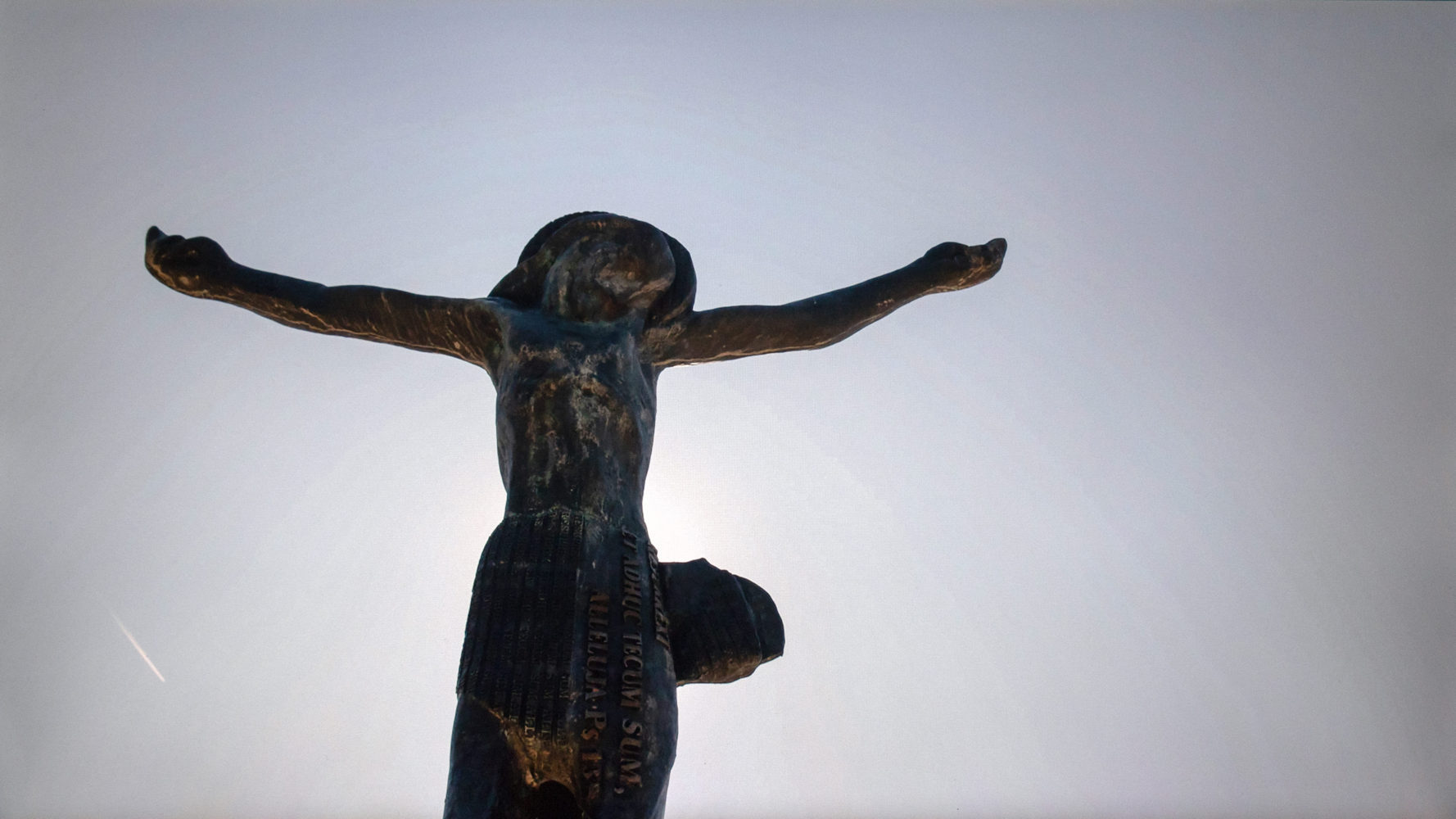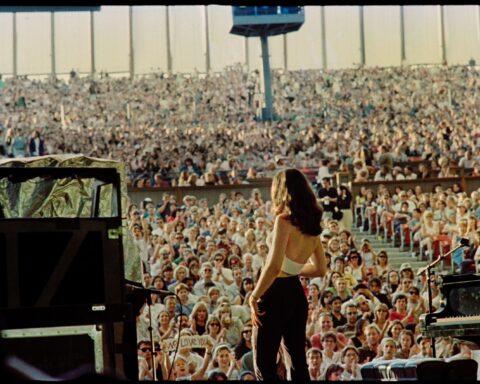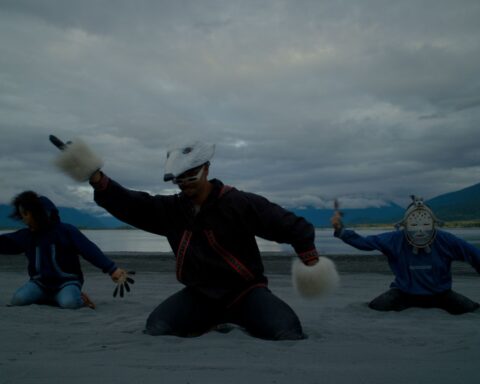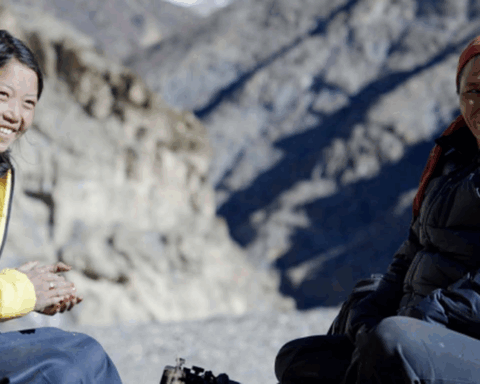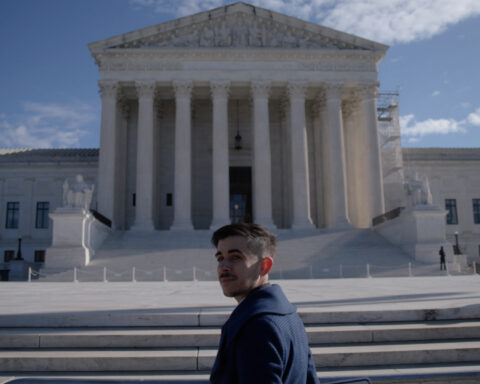“We don’t have a sense of what is real anymore,” says director Igor Drljača. “Like what is true and what is fiction. These tensions are inherent in these spaces.” The spaces to which Drljača refers are the Bosnian tourist sites featured in The Stone Speakers (Kameni Govornici). The Stone Speakers, which premieres in TIFF’s Wavelengths program, is Drljača’s first feature documentary after the dramas Krivina (2012) and The Waiting Room (2015), although his fiction films frequently incorporate non-fiction elements.
The Stone Speakers finds a different balance between fiction and non-fiction as Drljača explores the spaces stimulating Bosnia’s post-war tourism boom. Drljača, who fled the former Yugoslavia with his parents in 1993, presents images including derelict factories, exotic pyramids, bustling pilgrimages and scenic canals. These newly christened tourism hubs are also sites of memory, as audio interviews with local characters contextualize the locations. The doc has the humorous sensibility of a Denis Côté film, as Drljača lets the land and its inhabitants reveal their contradictions. The Stone Speakers conveys how any attempt to mythologize a nation invariably fictionalizes it.
Places, Spaces
The Stone Speakers delivers a travelogue of moving postcards as Drljača captures the sights of Bosnia through pensive long takes. The camera observes finer details that one might miss with only a casual viewing. “We often forget the inherent power of architecture and space in cinema,” says Drljača. “Those elements reveal aspects of the narratives within those places that you would not necessarily get unless you use duration-oriented cinematic forms.” Each location tells a story as the eye explores the frame. Audiences play the role of tourist while the interviewees serve as their (unreliable) audio guides.
The film begins with a scene in an abandoned factory in Tuzla, in which a woman speaks about the legacy of workers’ rights in the town. The speaker, a leader of the bargaining committee fighting for the factory employees, discusses how the working class is being robbed by the state. She emphasizes the class-based elements of the war over ethnic tensions and re-frames history to suit her story. In comparison, the mayor’s subsequent soundbite on Bosnia equally respecting all histories doesn’t jive with the images of decaying sites that Drljača presents. The tourism pitch is clearly still a work in progress.
Generation Exodus
Inconsistencies arise as the interviewees struggle to articulate a future with certainty. All the interviewees are elders, and the absence of youth is significant. “There are an increasing number of people that are leaving the country—like a massive exodus of young people,” explains Drljača, who interviewed several young people, but refined the edit when their responses regurgitated talking points about dire opportunities for work and family. Leaving the older generation to comment on the exodus underscores the paradox of a nation seeking renewal as its population declines.
Favouring the perspective of elders also reveals the flaws inherent in national mythmaking. In one scene, a tour guide speaks of his hometown, Višegrad, while highlighting aspects of the underground network beneath the pyramids of Visoko. “The Serbian town [Višegrad] was a predominantly Muslim town until ’92,” says Drljača. “They create this narrative that people are leaving, but the real reason there was a massive population decline is because they were ethnically cleansed.” Drljača adds that getting interviewees to speak of the war is dangerous and difficult. “If the inherent wartime elements come out,” says Drljača, “it is through the tension between the space and the contradictions of their statements.”
Mary and Emir
Markers of Bosnia’s controversial history appear throughout The Stone Speakers. Perhaps the most visually compelling (and amusing) images arise in the first chapter, “Quiet Revolutions,” which visits the holy site of Medjugorje. A speaker describes being one of six children who witnessed the Virgin Mary in 1981, while Drljača’s camera captures a bastardized spectacle as hordes of pilgrims seek to view the apparitions that allegedly continue. Even Pope Francis expresses skepticism toward the renewed sightings, but Drljača is less concerned with the legitimacy of the spectres. “What interested me was the defining characteristic of that space,” he explains. “It’s not just about the Catholic pilgrimage—it’s tied into Croatian nationalism and other elements that people just don’t talk about. These children saw this, but at the same time there were very specific politically-minded elements that entered the town about a year prior to the operation.”
Similarly, The Stone Speakers finds ironic humour in the chapter “A Renaissance on the River Drina.” In this space, Drljača documents the work of celebrated filmmaker Emir Kusturica, who created the town of Andrićgrad for an adaption of Ivo Andrić’s novel The Bridge on the Drina, which he has still not yet made. The Stone Speakers sees throngs of tourists enjoying barbeques and picnics amidst a hodgepodge of architecture that tries to compensate for the cultural renaissance Bosnia never had.
Drljača jokes that his doc combats perceptions that Kusturica brought tourism to the region with his controversial city. But Andrićgrad reveals its own contradictions, as Serbian nationalist images, perhaps imperceptible to viewers outside the local audience, pepper a town that purportedly isn’t fascistic. “Andrićgrad is an artificial creation that has nothing to do with the writer,” Drljača laughs. “It really has everything to do with this man’s take on history. It complicated this very fragile piece that was there.”
“What’s Past is Prologue.”
As The Stone Speakers witnesses a nation attempting to rebuild its identity in a post-war environment, there is a sense of history repeating itself. “The film parallels what’s happening today in the way that ideology is used to contextualize specific sites, just like the way the Civil War is commemorated in the USA,” says Drljača. “The events in Charlottesville came to mind when I was editing.” While the Charlottesville riots stemmed from the white nationalist group Unite the Right’s fight to preserve a statue of Confederate General Robert E. Lee, The Stone Speakers documents various artefacts preserving history. These statues, bridges, busts, and buildings suggest the permanence of things—emblems of old ideologies—but are also weathered by time.
“I found this ritualistic way of commemorating interesting to explore,” says Drljača. “Regardless of the ideologies at play, or the narratives, any tourist site marks a particular moment in history.” There is a sense of absence as these spaces reveal aspects of history at the expense of others. Tangible relics give voice to the citizens who can longer tell their stories.
“I don’t think a set-up exists for the country to have any sort of future that can be easily characterized,” Drljača says. “This film tries to project the future, but in doing so, it looks at the past.”




